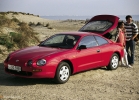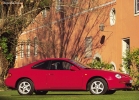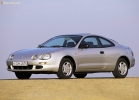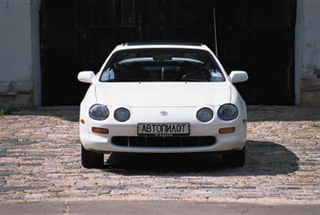Toyota Celica 1994 test drive - 1999 compartment
Karina II, eight years old
 Toyota cars have been lying on one of the most reliable in the world for many years. We decided to test this on their own, having bought 1989 for the editorial office of Toyota-Karin II.
Toyota cars have been lying on one of the most reliable in the world for many years. We decided to test this on their own, having bought 1989 for the editorial office of Toyota-Karin II. We were lucky: a good friend urgently needed money, and he decided to sell a car that was just driven from Holland-a sedan with a 90-horsepower 16-valve carburetor engine, equipped with a new Dutch gas-tank equipment. The price of 7.5 thousand dollars per car with mileage in Europe is about 150 thousand km, but not yet swallowing the dust of Russian roads, moreover, in an excellent state (there is neither a spot of rust, nor traces of road beatings), it seemed very attractive. At the prices of ZR, such a car could cost 8-9 thousand.
Having weighed all the pros and cons, we paid the agreed amount, and the expenses for the design of the car, as usual, were divided equally. Total $ 7600 for an eight -year -old foreign car. About the same amount of a new eight with a one and a half liter engine or a nine with an engine of 1300. Now it was necessary to answer a question that interests many readers: is it true that a used foreign car is better than a new domestic machine? Believe me, he disappeared by itself, as soon as he slammed the door from the inside - the old woman fascinated immediately.
A spacious salon, in front - comfortable wide chairs, the gap between them is sufficient so that the passenger and the driver do not touch each other's shoulders. The driver’s seat is adjusted for the lower back and a pillow tilt, so that a thousand miles at the wheel will not tire. The passengers are even more comfortable behind: the high back is tilted back, in it and pillows are made recesses, in which even a dormant body is confident.
The instrument panel looks quite modern: the upper circuit is a small wave, it successfully combines with the smooth contours of the instrument panel, console, glove box. The speedometer, by our standards, is huge. It is not necessary to peer into it, such as in a half -applied device of Samara. The type of economy meter is unusual: these are only two bulbs - green and orange. The first burns when you press the pedal smoothly, the second - if sharply and to the stop. You pay more attention to such an eco meter than an ordinary switch, so you often use its hint. Information the shield is not overloaded - other systems (lubricants, brakes, generator, etc.) are controlled only by signal lamps.
 All devices are clearly visible and almost not closed with their hands. The diameter of the steering wheel, the thickness of its rim, the location of knitting needles and supports for fingers and palms, and even more so the steering mechanism itself, apparently, were the subject of special concern of designers. To park, turn the wheels in place (even with wide tires of 185/70 R13, which have considerable resistance) without much effort. At the same time, a light steering wheel (a large gear ratio in the mechanism) does not interfere with the sensitively monitoring the behavior of the machine even in the boundary mode, when the car goes into skidding or side sliding.
All devices are clearly visible and almost not closed with their hands. The diameter of the steering wheel, the thickness of its rim, the location of knitting needles and supports for fingers and palms, and even more so the steering mechanism itself, apparently, were the subject of special concern of designers. To park, turn the wheels in place (even with wide tires of 185/70 R13, which have considerable resistance) without much effort. At the same time, a light steering wheel (a large gear ratio in the mechanism) does not interfere with the sensitively monitoring the behavior of the machine even in the boundary mode, when the car goes into skidding or side sliding. The levers of gear and parking brake are conveniently located. The first, with short moves, works perfectly: it is easy and clear that with a power unit located across, a rarity (remember the dangling lever of Samara). The parking brake of the ratchet with a small step. Stopping the car is so much more reliable than a lever with a large step, as, for example, in Lada.
The steering wheel switches also act clearly, as if there were no eight years of operation. The inclusors of the overall lamps and headlights, the windshield washer are unusually located: the first on the left lever, the second - at the end of the right.
A good Toyota glass washer causes one trouble. If the glass door is lowered, then the water, swept away, will certainly get into the salon, right on the jacket and trousers. The windshield is glued, and it does not have a seal that directs the streams of water. The front stand does not have a protrusion serving on other brands of cars with a reflector of water. Everything is sacrificed to streamlines.
 But the Japanese worked on the protection from the dirt of the thresholds. The chips on the thresholds effectively cut off dirt, sand, water flying from under the front wheels, preventing them from penetrating into the cracks between the doors and the body. The labyrinth seal in a pair of the punch does not allow even the dust to get into the salon. The purity of the thresholds rejoiced in the terrible autumn dirt. Passengers also paid attention to excellent sound insulation. Inside you can speak in an undertone, even at high speed.
But the Japanese worked on the protection from the dirt of the thresholds. The chips on the thresholds effectively cut off dirt, sand, water flying from under the front wheels, preventing them from penetrating into the cracks between the doors and the body. The labyrinth seal in a pair of the punch does not allow even the dust to get into the salon. The purity of the thresholds rejoiced in the terrible autumn dirt. Passengers also paid attention to excellent sound insulation. Inside you can speak in an undertone, even at high speed. Having examined Toyota inside and outside, we went to their laboratory for a more detailed acquaintance with the car. First we looked under the hood. On the motor and gearbox, there are almost no fluxes of oil and other liquids anywhere. Everything is dry, however, covered with a small layer of dust. So, the unit is most likely in good health. He took out the probe: the oil was enough, but judging by the color, it worked for a long time. We decided to fill the new, and at the same time change the filter. These are the first expenses for Toyota (except, of course, fuel). Four liters of Castrola -GTX5 (10W40, SJ/CF - semi -synthetics) were bought for 140 thousand rubles, and the champion filter - for 75 thousand, is a little expensive. It was selected in the store according to the catalog, and for fidelity it was compared with the machine installed.
Having replaced the oil, we checked its pressure on the heated motor with a manometer. With minimal idle speeds (850 rpm), it did not fall below 0.35 kgf/cm2, and at 3000 rpm, about 3.8 was held - great! There was confidence that the wear of the rubbing steam, primarily a crankshaft and liners, is small. They measured, of course, compression. Since two camshafts are installed in the cylinders head, the candles are located between them in deep wells, and the candles are less familiar to us - they are 16 under the hexagonal key. We found such a head under the cake of ordinary end keys in the nearest store for only 16 thousand rubles in the nearest store. . Wear of the electrodes of candles, the gap between them is normal. The carcass on the skirt of the insulator, like a well -tuned motor, is dark brown.
Compressometer readings: 12 units in one pair and 12.5 - in the other. The values \u200b\u200band their scatter also quite satisfied us. This indirectly confirms that the state of the cylinder-piston group, valves and their saddles are normal. This means that it can be hoped that the motor will work at least a hundred thousand before overhaul - replacing pistons, rings, cylinder bores, etc.
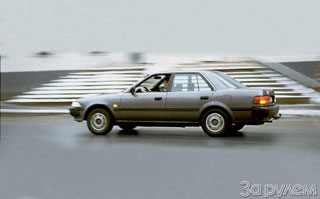 The previous owner assured that the car was served properly. Therefore, the belt of the gas distribution mechanism changed. The caring hand of the Dutch master deduced the corresponding inscription on the lid of the gear belt - replaced after a run 110 thousand km. So, the next shift is on the 200th thousand.
The previous owner assured that the car was served properly. Therefore, the belt of the gas distribution mechanism changed. The caring hand of the Dutch master deduced the corresponding inscription on the lid of the gear belt - replaced after a run 110 thousand km. So, the next shift is on the 200th thousand. They did not ignore the gearbox - they checked the oil level. They turned the cork (they did not immediately find it) and felt the oil with a finger in the hole. Transparent, by smell - transmission. Probably, the Dutch changed the oil simultaneously with the camshaft belt, and we decided to leave the transmission for another 50 thousand.
Raising the car, meticulously examined the condition of the front and rear suspensions, wheels, fuel drives, brake tubes. They did not find serious defects. Everything is in good condition: no cracks, no backlash, no corrosion, nuts and bolts are securely tightened. The body of the body was subsided in places where the metal can succumb to rust - near the arches of the wheels, thresholds. You can’t say anything, the armor is strong. They never got to iron. Everything was processed for conscience, probably even at the factory with a very strong protective composition.
But still (we can see everything from below), the car has a drawback. The road clearance and the so -called angles of entry and congress are small for Russian roads. This was noticeable: our comrade had already drove a little apron (spoiler) of the body under the front bumper, sat a couple of times on the belly, leaving two dents near the thresholds, and more than once hooked the border with the lower part of the trunk - a niche of the spare wheel. We realized that we should be more accurately parking at the high curbs, and at the same time to be ready to rescue the car even from a small puddle on the countryside.
When they lowered Karin from the lift, they studied the condition of the body outside. Gray metallic is covered with a rather thick and durable layer of varnish. It is well opposed to abrasive wear: a washed car even without polishing shines like a new one. The scratches on the varnish are almost not visible. The coating holds stones. On the front edge of the hood, potholes are barely noticeable. Such paint should resist and protect the body even in our harsh conditions.
We looked into the hidden cavities with an endoscope - they did not find rust. For persuasiveness, two doors were dismantled - there is also only an anti -corrosion coating.
We looked closely at the gaps of the body panels. All even and small, nothing puffs and sags - it means that the body is still tough. The locks and loops of the doors are carefully lubricated, you do not need to clap.
Well, the state of the most expensive details is excellent - therefore, we did not spend money in vain: the car will still serve.
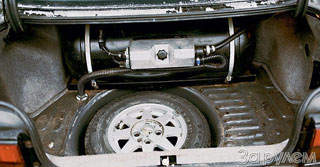 The last thing to check is the work of shock absorbers, brakes, suspension geometry and headlight settings. We went to the Center for Instrumental Control of Niiat. On German running drums, a vibration stand and a special lift, the check determined: the shock absorbers correspond to the norm, but their residual resource is small, especially in the rear. The brakes are in good condition and satisfy even strict German requirements. The angles of the wheel installation are ideal - the front wheels will not be separated from each other on one kilometer by a centimeter, and the rear - only 4 meters. For example, the new Lada of the wheel at such a distance diverge tens of meters, and the Muscovite has even more. However, if you wish, you can adjust the convergence of the rear wheels - there are special experts in the suspension. Lufts in the suspension, wheel hubs bearings, steering are also normal, that is, almost imperceptibly. For such a run, according to our ideas, the result is very good.
The last thing to check is the work of shock absorbers, brakes, suspension geometry and headlight settings. We went to the Center for Instrumental Control of Niiat. On German running drums, a vibration stand and a special lift, the check determined: the shock absorbers correspond to the norm, but their residual resource is small, especially in the rear. The brakes are in good condition and satisfy even strict German requirements. The angles of the wheel installation are ideal - the front wheels will not be separated from each other on one kilometer by a centimeter, and the rear - only 4 meters. For example, the new Lada of the wheel at such a distance diverge tens of meters, and the Muscovite has even more. However, if you wish, you can adjust the convergence of the rear wheels - there are special experts in the suspension. Lufts in the suspension, wheel hubs bearings, steering are also normal, that is, almost imperceptibly. For such a run, according to our ideas, the result is very good. The last were the headlights. A sensitive device determined the correct settings and a decrease in light strength by 15% compared to new ones. And also caught a small difference in the brightness of the right and left headlights. But all this corresponds to the norm. Later, comparing the light of Toyota and the one-year-old Samara on the road, we concluded that Karina II is still better: a little brighter and clearer than the border of the bundle.
After such a thorough check, it was possible to go to the city with a dense flow of cars without fear or prepare for a long run! How Karina II behaved on Russian roads - more on this in the following reports.
The three -spoke steering wheel, an informative instrument shield, a platform -update under the left leg, a console of the panel of the instrument panel to the driver - all together gives the machine sports.
In a 70 -liter cylinder, you can download about 60 liters of gas (1000 rubles per liter) - and drive as much as 700 km on it! In the niche - a full -size reserve (185/70R13). For our roads, such a better wheel.
At low speeds, a 16-valve double-sized 1600-cow motor pulls confidently, while he turns Karina into a sports car.
The trailer device and an additional set of winter tires with disks (they are on Toyota) became good arguments in favor of buying a machine.
Toyota-Karina II (crown) 1.6 XL (sedan) Toyota Carina II (Korona) 1.6 XL
TECHNICAL SPECIFICATIONS
General data: number of places - 5; equipped mass - 1050 kg; maximum speed - 180 km/h; acceleration time from a place to 100 km/h - 11.5 s; fuel consumption (gasoline) at 90, 120 km/h and Hz - 5.4; 6.9; 8.8 l/100 km; the volume of the fuel tank - 55 l; The octane number of gasoline is 91 and 95. Dimensions, mm: length - 4440; width - 1690; height - 1380; base - 2525; The track in front/back - 1455/1470; Road clearance - 160; trunk volume - 535 l; turning radius - 5.5 m. Engine: model - 4A -F; gasoline, carburetor, four-cylinder, in order, with two distribution shafts, 16-valve; working volume - 1587 cm; the diameter and stroke of the piston - 81x77 mm; compression degree - 9.5; The maximum power is 66 kW/90 liters. with. at 6000 rpm; Maximum torque -
135 Nm at 3600 rpm. Transmission: drive - on the front wheels; gearbox - mechanical five -speed; Transporting numbers: I - 3.545; II - 1.904; III - 1.310; IV - 0.969; V - 0.815; h. X. - 3.250; The main program is 3.722. Suspensions: the front - independent, such as McEferson; The back is independent with parallel transverse levers, longitudinal bar, springs, telescopic shock absorbers and a pure stability stabilizer. Brakes: with an amplifier, front - disc ventilated, rear - drum. Tires: 185/70 R13.
Vyacheslav Subbotin. Photo by Vladimir Knyazev
A source: The magazine "Driving"


